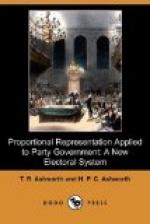rejected, and his votes transferred to the next available
preference on his ballot papers; then the next lowest
would be rejected, and so on till all the votes were
equally distributed among the 654 members. Such
was the Hare system as propounded by its author.
The electors were to divide themselves into voluntary
groups; then the groups which were too large were
to be cut down by transferring the surplus votes,
and the smaller groups were to be excluded and the
votes also transferred until the groups were reduced
to 654 equal constituencies. These two processes,
transferring surplus votes and transferring votes
from excluded candidates, are the main features of
the system. Mr. Hare’s rules for carrying
them out are drawn up in the form of a proposed electoral
law, and in the different editions of his work the
clauses vary somewhat. They are also complicated
by an impossible attempt to retain the local nomenclature
of members. As regards surplus votes it was provided
that the ballot papers which had the most preferences
expressed should be transferred; still a good deal
was left to chance or to the sweet will of the returning
officer, and this has always been admitted as a serious
objection. The process of elimination is still
more unsatisfactory. Mr. Hare was from the first
strongly opposed to the elimination of the candidate
who had least first preferences, and he therefore
proposed that, in order to decide which candidate
had least support, all expressed preferences should
be counted. This involved such enormous complication
that in the 1861 edition of his work he abandoned
the process of elimination altogether in favour of
a process of selection. He then proposed to distribute
surplus votes only, and to elect the highest of the
remainder, regardless of the fact that they had less
than a quota. He then wrote:—“The
reduction of the number of candidates remaining at
this stage of the election may be effected by taking
out the names of all those who have the smallest number
of actual votes—that is, who are named
at the head of the smallest number of voting
papers, and appropriating each vote to the candidate
standing next in order on each paper.
This process would be so arbitrary and inequitable
in its operation as to be intolerable. It might
have the effect of cancelling step by step more votes
given to one candidate than would be sufficient to
return another.... Such a process disregards the
legitimate rights both of electors and of candidates.”
But the process of selection was not proportional
representation at all, being practically equivalent
to a single untransferable vote, and Mr. Hare finally
adopted, in spite of its defects, the “arbitrary
and inequitable” process of elimination in his
last edition in 1873. And all his recent disciples
have been forced to do the same, because nothing better
is known.
Mr. Hare’s scheme has ceased to be of any practical interest, since it is now generally admitted that electorates should not return more than ten or twenty members. Moreover, it is admitted that the electors would group themselves in very undesirable ways, and not as Mr. Hare expected. And yet the only effect of limiting the size of the electorates is to reduce the number of undesirable ways in which electors might group themselves. Let us briefly note the different proposals which have been made.




